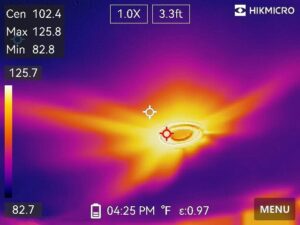Yesterday I wrote about the ways heat moves into our homes through conduction, convection and radiation.
- Today we’ll look at some actual numbers for a recent home performance test.
Why it matters: Knowing where the heat is getting in helps us develop strategies to keep it out.
🔬 Zoom in: Using an infrared camera, we can “see” the heat and measure it under normal conditions and while running the blower door test (BD).

🧮 By the numbers: Here are the temperatures we measured inside the house plus a tip for addressing it.
- Outside temperature was 103F. Attic temperature was 130F.
👉 Around the door to the garage
- Normal = 92.5F, BD = 100.2F
- Weatherstripping this door will help.
👉 Pull down attic stairs
- Normal = 102.4F, BD = 119.3F
- Attic access inside your living space (i.e. not in your garage) needs to be addressed with an insulated and sealed attic tent.
👉 Recessed can lights
- Normal = 101.8F, BD = 125.8F
- Can lights need to be air sealed to prevent this leakage.
👉 Fur downs
- Normal = 91.9F, BD = 102.4F
- Any change in ceiling height (with a fur down or in a hallway or bathroom) usually means the framing in the attic has created gaps and cracks where heat can get in.
✅ For your Smart Homeowner list
- Walk around your house and notice any penetration in the ceiling that’s underneath unconditioned attic space — first floor penetrations immediately under a second floor aren’t an issue.
- Those are the most likely places where you’re fighting against heat trying to get into the house.
Best,
Travis
P.S. I’ve been booking more 20 minute Home Energy & Performance Consults. Let me know if you’re ready for help.
